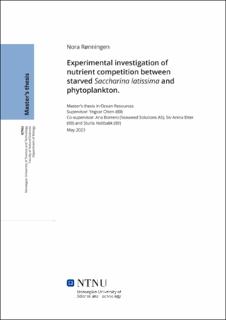| dc.description.abstract | Kultivering av makroalger er en bærekraftig industri med stort potensiale for å produsere mat og andre produkter. Makroalger kan derfor være en viktig kilde til å øke matsikkerheten til den økende globale befolkningen. Kunnskap om næringsopptak, vekst og interaksjoner makroalgene har med økosystemet er viktig for å kunne øke makroalgeproduksjonen. Næringsstoffer er en av nøkkelfaktorene som begrenser vekst hos makroalger. På vinteren er næringskonsentrasjonen i sjøvann høy på grunn av liten lagdeling og lite blanding av vannmasser i vannsøyla. Ved økt lys og temperatur i løpet av våren blir næringsstoff den begrensende faktoren. Dette skyldes at temperaturen danner lagdeling i vannsøylen og fytoplankton har våroppblomstring. Interaksjon mellom makroalger og fytoplankton kan oppstå når de lever i samme miljø og bruker de samme ressursene for vekst og andre metabolske prosesser. En slik interaksjon har skapt bekymring for at kultivering av makroalger kan ha en negativ påvirkning på økosystemet.
Formålet med denne masteroppgaven var å undersøke om fytoplankton og Saccharina latissima konkurrerer om næringsstoffer, og for å se om gjødsling kan øke næringsstatusen, vekstraten og konkurasedyktigheten til S. latissima. For å undersøke dette ble det utført et eksperimentelt gjødslingsforsøk i et utendørs sjøvannsbasseng i Trondheim, fra slutten av februar til begynnelsen av juli. Eksperimentet inneholdt to behandlinger av S. latissima; en kontroll gruppe (CTL) med uforstyrret sporofytter i bassenget, og en gruppe med sporofytter som ble gjødslet (FER) i en ekstern tank i 24 og 48 timer. FER sporofyttene ble gjødslet med uorganisk nitrat (NO3-) og fosfat (PO43-). Intracellulært næringsinnhold, netto opptak og vekstrate i de to behandlingene ble undersøkt og sammenliknet med næringstatusen og veksten til fytoplankton.
Resultatene viste at fytoplankton hadde maksimal vekst og høy biomasse igjennom hele eksperimentet og var derfor upåvirket av S. latissima. Ved hjelp av Droop-modellen ble en korrelasjon mellom spesifikk veksthastighet og intracellulære næringsinnhold i S. latissima etablert, der de unge sporofyttene målt i vinterperioden hadde høyest intracellulære næringsinnhold (Qm) som førte til maksimal veksthastighet (µmax). De høye næringsverdiene indikerte at sporofyttene hadde høyest lagringskapasitet i vinterperioden og at den intracellulære næringen ble brukt til vekst når næringskonsentrasjonen i vannet sank. Resultatene viste også en signifikant forskjell mellom vekst, helse og næringsinnhold i CTL og FER sporofyttene i juni. CTL sporofyttene som ikke ble gjødslet og levde i samme miljø som fytoplankton hadde sterk næringsmangel, nedgang i vekst, opptak av næring, klorofyll a og vev med lav eller ingen fotosyntetisk aktivitet. FER sporofyttene, hadde derimot et positivt netto næringsopptak vekst, fotosyntetisk aktivitet og viste økte intracellulære næringsstoffverdier. Disse resultatene antyder at det er en konkurranse mellom S. latissima og fytoplankton når det kommer til opptak av næringsstoffer fra omgivelsene. I tillegg økte konkurransedyktigheten til opptak av næring i S. latissima ved at de ble eksponert for høye næringsstoffkonsentrasjoner. | |
| dc.description.abstract | Large scale cultivation of seaweed is a sustainable industry that can be used as food for human consumption and other products. Seaweed is an important source for the food security of the growing human population. To upscale the production of seaweed, knowledge about the nutrient uptake, growth kinetics and interactions with the ecosystem are essential. Nutrients are key factors that limits growth of seaweed. During the winter the nutrient concentration in seawater is high due to mixing of the water column. However, when light availability and temperature increases during the spring, nutrients become the limiting factor, due to stratification of the water and phytoplankton bloom. Phytoplankton and seaweed compete for the same resources for growth and other metabolic processes. The potential interaction between phytoplankton and seaweed have raised a concern. Recent publications have described potential impacts to the phytoplankton communities derived by a large scale of seaweed cultivation.
Based on this, the aim of this thesis was to investigate if there is a competition of inorganic nutrients between phytoplankton communities and Saccharina latissima, and if a fertilization treatment could increase the competitive ability, growth and nutritional state. To do so, an experiment was carried comparing one control (CTL) treatment that were undisturbed, and one treatment where the sporophytes (FER) got a boost of nutrients for 24 and 48 hours with inorganic nitrate (NO3-) and phosphate (PO43-) in an external tank. Nutrient composition, net uptake, and growth of the two treatments were examined and compared with water samples that showed the nutritional status of phytoplankton.
The results showed that the phytoplankton community had maximum growth and high biomass during the whole experiment and was not negatively affected by S. latissima. By using the Droop-model a correlation between specific growth rate and the internal nutrient content in S. latissima were found, it also showed that the young sporophytes in the winter period had the highest internal nutrient content (Qm) that lead to maximum growth (µmax). The high nutrient content in the winter period, suggested that the sporophytes have higher storage capacity in the winter and uses it for growth when the ambient nutrients decrease. The results also showed that there was a significant difference in growth, health and nutrient composition between the FER and CTL sporophytes in June. The CTL sporophytes showed decreasing nutrient content, chlorophyll a level, growth, negative net uptake, and tissue with low or no photosynthetic activity. The FER sporophytes on the other hand showed increased values of nutrient content, Chl a, growth, net uptake of nutrients and photosynthetic efficiency. By comparing the phytoplankton, CTL and FER sporophytes, the results suggested that there is a competition between S. latissima and phytoplankton when it comes to taking up nutrients and that fertilization treatment can increase the competitive ability of nutrient uptake. | |
